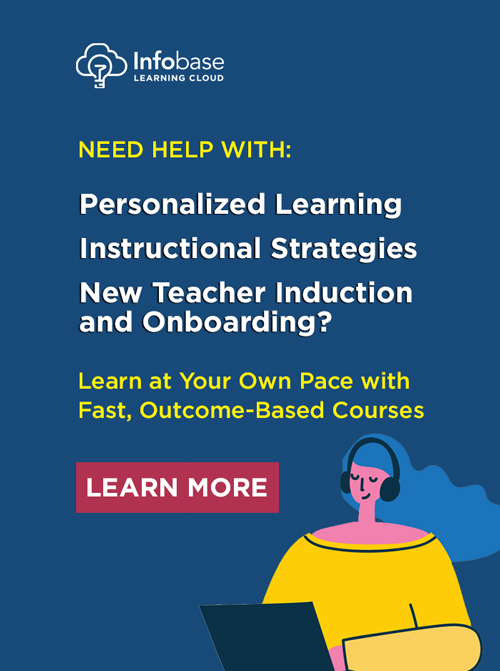“When technology integration is organic, it emerges naturally. It is not forced.” —Adam Juarez & Katherine Goyette, The Complete EdTech Coach
 In 2021, we have seen a move from traditional on-site or physical classroom learning to more online or remote instruction. Usually, online learning is conducted in one of two key forms: asynchronous, when learners complete their learning on their own time without restrictions on place or time, or synchronous, when the learning and teaching happen in real time through online virtual video conferences, chat, or audio communication. They both have their strengths and weaknesses when it comes to understanding and choosing your learning style and designing your online course.
In 2021, we have seen a move from traditional on-site or physical classroom learning to more online or remote instruction. Usually, online learning is conducted in one of two key forms: asynchronous, when learners complete their learning on their own time without restrictions on place or time, or synchronous, when the learning and teaching happen in real time through online virtual video conferences, chat, or audio communication. They both have their strengths and weaknesses when it comes to understanding and choosing your learning style and designing your online course.
An approach that I discovered over five years ago and have been slowly enacting and integrating as both classroom teaching and technology integration is the blended learning model. The blended learning model is described as an approach to learning that mixes and combines face-to-face instruction with online learning experiences. Some of the most popular blended learning models are:
- Flipped Classroom
- Rotation of Stations
- Hybrid Model Approach (In-class instruction followed by online lesson creation and participation)
- Project-Based Learning
- Interactive Approach
- Ditching the Textbook

However, while these examples are well documented, knowing where to start can be tricky. In fact, as an experienced educator for over a decade—as a classroom instructor, technology director, and instructional enrichment coach—I have learned that there is no true “magic” bullet when it comes to one or the other. Using a blend of some of the models described above (there are over 20 types) has guided me in creating not only online instruction, but also a classroom curriculum that works for students and even fellow educators in both a physical and digital form.
The first step is looking at the classic 4 Cs of education and later the 7 Cs of education. What are the 4 Cs?
- Critical Thinking
- Creativity
- Collaboration
- Communication
To many, this is pretty much a road map for guiding instruction: having students think critically about what they are learning, be creative in how they express and convey their learning and thinking, and collaborate within and outside their classroom, both physically or digitally.
The last 3 Cs are:
- Community
- Computational Thinking
- Change Makers
These last three Cs are really where creating a blended learning curriculum becomes essential. What is the community you are trying to create as part of your lessons? How are students making these connections to their own daily lives and other learning environments? How will they do it “differently” in a way that will inspire change and allow breakthroughs in not only their learning, but the teacher’s lessons in the future? That’s where many educators get stuck.
Community and computational thinking are used regularly in the classroom because, no matter how many times you perform the classic light a candle and put a glass over it, no matter how much you try, the lesson is going to show that, when the oxygen runs out, the fire on the candlewick is eventually going to go out. But how do you create a lesson that inspires change in how a student learns and understands? That’s the big question many struggle with; I know I have. The best way to start creating your blended learning curriculum is to ask the following questions:
1. What do I have available to me right now?
Are you an educator blessed with desktop or mobile devices using something like the GSuite Applications or a Microsoft application with a learning management system like Google Classroom, Canvas, or Schoology?

2. How can I use them?
Just because you have some of the necessary tools doesn’t mean you can just expect a lesson or curriculum to build itself. You have to know or understand how to apply them. A simple plan might be introducing students to the various types of classification of jobs. They can be given a table with the classification term and instructed to do a web search or use their terminology list to define the classification, list at least two facts and characteristics, use it in a complete sentence, and then give a digital image example of the classification.
3. Do my students know how to use these tools?
The biggest mistake all instructors make is that just because someone grew up in a world using online resources and devices doesn’t mean they know how to use them. I still have students (and adults) who don’t know they must put a subject line in an email. Otherwise, it might be marked as spam or thought to be a phishing/virus email bug. Something you need to know right off the bat—don’t expect your learners to automatically “know” how to use something because “it’s been around for years.” You still have to learn how to do something. You want to make sure that, if you are going to start developing your blended learning, that there is room to give instruction on the basics of use. As the old saying goes, “You don’t just jump in a car and turn the key and expect to know how to drive.”
4. Will this not only be beneficial to my learners, but will I be learning in the process as well?
Something educators are guilty of is staying stuck in their ways, and blended learning can help you move past that. No matter how much you try, a worksheet, even when done in a digital format, is the same worksheet, just not on paper. I’m not putting down worksheets—they still have places in the classroom as they are the classic way of showing understanding in many subjects. But, if you give a learner a spreadsheet to balance a bank account after paying bills, that’s still the same as doing it on paper. You are not moving forward in your teaching—you are just using something old and giving it a new coat of paint, and that doesn’t really go into the 7 Cs.
5. Can I pace myself?
Let me tell you right now, very rarely are you going to be able to create something that will magically be an awesome blended lesson. You HAVE to go slowly. As I mentioned above, just because you know how to use email, it doesn’t mean your learners automatically know how to. I think my biggest shock was four years ago when I came into a classroom that had laptops and desktop computers available, and the freshmen didn’t even know how to log into them. Same thing when I asked them to go to their cloud drive. They CONSTANTLY typed in “Google Drive” instead of just hitting the nine dots as soon as they went to their browser and then clicked on the icon. When I asked, they replied, “My teachers always told me to do that.” That in turn caused a delay in the lesson and learning because the students were wasting time typing in the search box, then clicking in the link, and then trying to navigate just to get to the “new button.”
If the teachers had just given a simple five-minute introductory lesson on how to navigate to their cloud drive and where to go from there, not only would they have taught their students a valuable skill, they would have in turn become more productive in their way of conveying the lessons. Don’t just jump into the deep end of the pool and expect to swim; follow the previous questions and pace yourself. A great blended learning curriculum doesn’t happen in one lesson or even one unit. It takes time, but don’t get yourself hung up either. If you can’t pace yourself, you are going to come to a complete halt by going too slow or too fast.
6. Can I fail today?
 Yes, I said it: are you going to fail? As much as we want to be perfectionists, thinking that something turning into a complete hot mess means we should just drop it and never look back is completely wrong. We have to learn from our failures; we have to learn from our mistakes or pieces that didn’t work. You know how many lessons I had that blew up in my face? More than my age, and I’m in my early 40s. Did I have lessons that worked for a long time and then one class or one day they didn’t? You bet I did. I had a blended learning lesson that worked for over two years until one semester, not only did my classroom find it uninteresting, I had many of them call it “dumb and useless.” What did I do? I decided to ask WHY they thought that way and looked to improving it. Guess what? The following semester, those previous students who had thought it was just a waste of time heard what we did instead and said, “Can I come back and try that again this way?” Remember what I said in the 7th C, Change Maker? Well, there it is. As Yoda once said, “The greatest teacher, failure is.” We learn from our mistakes, as simple as that.
Yes, I said it: are you going to fail? As much as we want to be perfectionists, thinking that something turning into a complete hot mess means we should just drop it and never look back is completely wrong. We have to learn from our failures; we have to learn from our mistakes or pieces that didn’t work. You know how many lessons I had that blew up in my face? More than my age, and I’m in my early 40s. Did I have lessons that worked for a long time and then one class or one day they didn’t? You bet I did. I had a blended learning lesson that worked for over two years until one semester, not only did my classroom find it uninteresting, I had many of them call it “dumb and useless.” What did I do? I decided to ask WHY they thought that way and looked to improving it. Guess what? The following semester, those previous students who had thought it was just a waste of time heard what we did instead and said, “Can I come back and try that again this way?” Remember what I said in the 7th C, Change Maker? Well, there it is. As Yoda once said, “The greatest teacher, failure is.” We learn from our mistakes, as simple as that.
7. Can I ask for help?
You can do all the research and watch plenty of videos, but there will always be that situation where you don’t understand something or you want to see a live model of how it works. Know this, everyone: you can ask for help. I’ll tell you right now, when I came to my current district, I had been working on blended learning for a while, but I knew I was missing some key factors. One of my mentors showed me how to stop lecturing and allow students to learn at their own pace. I asked her to show me what she was doing, and she was more than happy to. I also came up with several different ways for my blended lessons to be more productive or to get students out of the habit of searching for everything under the sun. She then in turn asked me, “Can you help me come up with a better way to use this model?” This goes right back to the Community aspect of the 7 Cs. Create that PLN (professional learning network) either in person or online. If something isn’t working, know you can reach out to someone who has made it work or found a great use for a tool you are using for your curriculum. I once used a tool that I saw in a math room over a subject that still sends me to the corner of the room, but I saw something that really engaged that class’s learners. I asked what it was and how it worked. A week later I brought it to my classroom, and I had a few students from that same class comment, “I never knew I could use it this way.” What happened later? That same teacher who taught me the tool turned around and adopted some of the learning avenues I used in the classroom and then shared it with their department. The 7 Cs swing both ways. The hardest thing to say is, “I don’t know.”
Ok, enough of this. You know you have read this, but can I put my words of advice into practice? Let’s look below.
| Lesson: Unit 1: Chapter 1: Collar Jobs | |||
| Lesson: Students will be introduced to the different classifications of careers and jobs in the modern business world, both physical and digital. | The lesson will be divided into a 10-to-15-minute instruction that will be interactive and include time for Depth of Knowledge Questions and discussion, followed by creating a set of Frayer Cards they will later use for study aids both during the chapter and Unit Test in three weeks. | ||
| Tools | What Do They Do? | Devices | Lesson Notes |
| Pear Deck | Digital tool that allows students to interact with a presentation and allows for questions and instructions, both paced by the instructor and learners. | Can be used on any desktop or mobile device. | Presentations will be created in Google Slides/PowerPoint based on current facts and practices using ISTE and NGBF Standards. |
| Google Classroom | Local Learning System available to my district where the main lesson and Daily Assignment list will be accessible to my learners. | Works through any desktop, Chromebook, or laptop computer that is logged in to Gmail services. Mobile devices need to use the app. | Students must be logged in to their GSuite to access. |
| Quizlet | Online flashcard system. | Works on any device or application. | Teacher must create flashcards first or have shared a previously created card set with their students. |
| Google Slides | Online presentation software similar to PowerPoint, where students will be able to access their Frayer Cards template to research and apply their knowledge of collar jobs. | Available on all devices. | Template will be created by the teacher, along with an instructional video on how to use the template, and then posted in Google Classroom. |
| Due Date | Turn-in date set on Google Classroom. | Part of Google Classroom. | Keep date flexible in case students have technology issues or other circumstances outside of the classroom. |
There you go: a simple breakdown using all the matrixes I have talked about before using those seven key questions and the 7 Cs. Is it perfect? Of course not, nothing is perfect, but it’s a great way to start your path to creating your blended learning curriculum. Start asking yourself these questions today, look at your tools, know that it’s going to be messy—but at the same time rewarding—when your students make those connections and go forward into becoming lifelong learners.
References:
- Sail the 7 Cs with Microsoft Education by Becky Keene & Kathi Kersznowski
- Blended Learning with Google by Kasey Bell
- Ditch That Textbook by Matt Miller
- Project-Based Learning Anywhere by Dr. Lori Elliott
- Courageous EDventures: Navigating Obstacles to Discover Classroom Innovation by Jennie Magiera
See also:
- Discover Infobase Learning Cloud Professional Development & Training!
- Solution Showcase: Personalize Your Professional Learning
- Trending Professional Development Topics in Our New Reality
- How to Improve Teacher-Student Communication in Virtual Classrooms
- Gamification: How Online Educational Games Keep Students Engaged in Virtual Learning
- Beyond Discussion Boards: Applying Interactive Tools and Assignments for Learning



